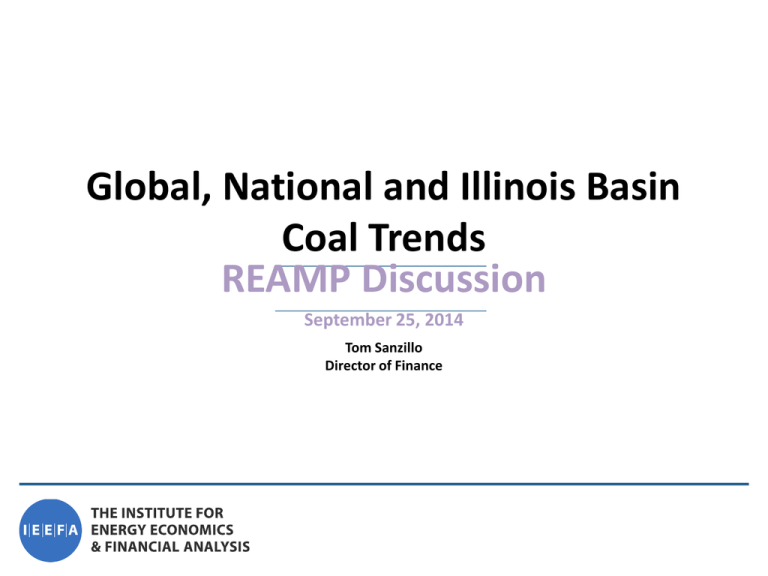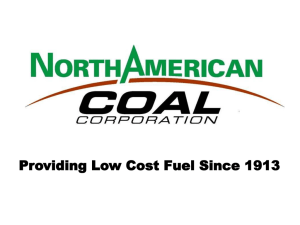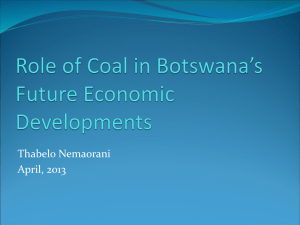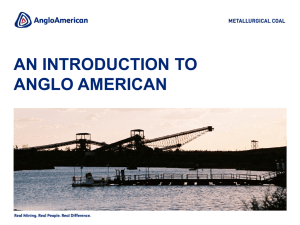Global, National and Illinois Basin Coal Trends
advertisement

Global, National and Illinois Basin Coal Trends REAMP Discussion September 25, 2014 Tom Sanzillo Director of Finance Global Coal Production 2008-2013 Coal Production (billion tons) 9 8.5 8 7.5 7 6.5 2008 2009 2010 2011 Coal Production 2012 2013 World’s Largest Producers 2013 Production 4000 3500 3000 2500 2000 1500 1000 500 0 China United States India Indonesia Russia Australia Germany Poland 2013 Production Worlds Largest Consumers 2012 Consumption 4500 4000 3500 3000 2500 2000 1500 1000 500 0 2012 Consumption Global Imports/Exports: Global Trade 2012 1.4 billion 2013 Importers (million tons) 2012 Exports (million tons) 350 300 250 200 150 100 50 0 450 400 350 300 250 200 150 100 50 0 2013 Imports 2012 Exports Million tonnes of coal equivalent (Mtce) 9000 8000 7000 6000 5000 4000 3000 New Policies Current policies 2000 450 1000 ETA/IEEFA 0 2000 2005 2010 2015 2020 2025 2030 2035 Major Drivers of Demand Curve • China: Thermal coal demand peaks early in the 2015-2020 period and declines to below 2010 levels by 2035. China becomes an opportunistic exporter on any thermal coal price strength. This equates to rates of decline up to -0.9% CAGR in 2020-2035. This reflects: • Continued energy efficiency gains reducing the ratio of electricity to GDP growth; • Slower GDP growth and a transition towards less energy intensive sectors; • Increased thermal power plant efficiency; • Technology gains, particularly battery storage, solar, on and offshore wind; • Continued electricity supply diversification i.e. more gas, nuclear, wind, solar and hydro; and • Beyond 2020 offshore wind will then step up as another area of diversification. – India, Japan, U.S., Korea and Taiwan UNITED STATES COAL MARKETS Coal’s Share of U.S. Electricity LT Decline Coal vs. Natural Gas Percentage of All U.S. Electricity Generation (2002-2013) 60.00% 50.00% 40.00% 30.00% 20.00% 10.00% 0.00% 2002 2003 2004 2005 2006 Coal 2007 2008 2009 2010 2011 2012 2013 Natural Gas 11 Electric Sector Coal Consumption Chart Title 1200 1000 800 600 400 200 0 2008 2009 2010 2011 Coal Consumption 2012 Estimate 2013 2014 An ILB Leader Sums Up • “We have the absolute destruction of the American coal industry. If you think it's coming back, you don't understand the business,” Murray Energy CEO Bob Murray remarked to hundreds of coal industry executives at the Platts 37th Coal Marketing Days. “Or you're smoking dope.” • Murray further claimed that publicly traded companies like Peabody are being dishonest with their investors for public relations purposes about the future of coal. • “You got to be the low-cost producer every day, in every region. Everything else is public relations garbage by public companies that are worried about stock prices,” Murray said. ILLINOIS BASIN ILB: Growth Story • Only major growth story in US Coal markets – Since 2009 – 25% growth, CAPP down 14% – 2012 – 127.5 mtpa; 2013 – 132 mtpa • Why growth story? – High BTU, high sulfur coal – Scrubbers – more intense emissions goals seen helping ILB producers, most retirements CAPP – Lower cost of production – Solid Margins ILB: Fundamentals • Basic Economics – Prices Received: 2012: $49.20 – Costs of Production: $34.93 – Margins in: $14.00 to $30.00 range • Despite erosion in prices in 2013-2014: $44.00 per ton, Basin still growing. • ILB cost of production rose by 6% per year since 2007, CAPP up over 8% per year. Investment Taking Place • Major Companies all expanding operations with new mines in construction and under permit • Largest Producers – Peabody, Alliance, Foresight, Murray and Armstrong – Strong cast of smaller players: Knight Hawk (Arch), Vectren, Hallador Exports and Potential • Companies geared up for more exports – Foresight led in 2012 with 7.7 mtpa off based of 16 mtpa. – 2013 and current year price collapse globally, lower exports – approximately 7 mtpa. • Port of New Orleans – 92% of ILB exports multiple terminals and Port of Mobile Exports and Potential • Where is market – Americas (Canada, Chile, Mexico) – Europe (France, Great Britain, Germany, Spain) – Asia (China, India and South Korea) Risks • Although margins are solid for Foresight and Alliance – Arch, Peabody hurt by price erosion. – How long can they handle low prices • Soft global markets undermine larger efforts of combining domestic and export mix. • Old Customers buying more – Duke, TVA, Southern, but in context of overall coal demand decrease.








